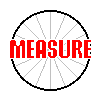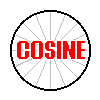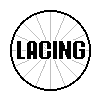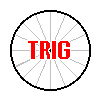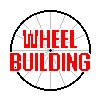



















| |
| |




















|
RADIAL LACING INFORMATION




















| |
| |




















|
Radially laced wheels are the easiest to build. You don't have to make sure the valve stem has clearance and you don't have to carefully thread the spokes when working on the crosses to try to keep from scratching the rim. With a radial wheel the only thing you have to decide on is whether the spokes will come from the inside or the outside of the flanges. It is possible to have them alternate to form a pattern for looks, but they must be balanced. For instance, if you radially laced a front wheel with the spoke heads facing in on one flange and facing out on the other, all you have done is created a wheel that needs some dish offset to be trued.
Spokes react differently depending on which side they are anchored. One way they can anchor is with the heads on the outside of the flange. This makes the wheel slightly (very slightly) more aerodynamic, since the spokes form a slightly narrower formation. This also makes the heads of the spokes visible when looking at the wheel, which has an aesthetic appeal. This lacing is, however, the weakest of the two. The spoke bend, where the spoke enters the hub, is solely responsible for the lateral forces and stresses. The bend also takes a hard hit from the vertical stresses. All of the shock traveling down the spoke leverages around the small point where the spoke bends as it enters the hub.
The other way to do a radial lacing is with the spoke heads on the inside of the flange. One sees the spoke itself crossing and entering the face of the hub when viewed from the outside. Stresses seen by the spoke are absorbed in the small length of the spoke that rests against the hub flange between the spoke hole and the edge. This radial lacing is stronger in relation to both spoke breakage and lateral strength. In respect to spoke breakage, having the spoke flexing over the small area resting against the flange is stronger than having the flexing occurring at it's bend. For lateral strength, since the spoke is further away from the center of the hub it has the highest static strength, and since lateral shock stresses are absorbed by the section of spoke crossing the flange it also has greater dynamic strength.
The only thing you should not do with radial lacing is grease the threads of the spoke. A spoke prep formula that locks the nipples after assembly can be used, but regular grease should be avoided. The reason you should not use regular grease is because the spokes are directly in line with their main force vectors from the rim to the hub.
With all conventional spoked wheels the build tension on the threads is the only thing that keeps the nipples from loosening. When a spoked wheel receives a vertical stress shock, the spokes closest to the area of the rim that received the stress get relaxed, and the spokes at the opposite side of the wheel undergo a tension increase. The tensions then quickly return to normal. In a radially laced spoke the shock wave forces on the spoke threads is even all the way around the threads, there is no imbalance that tries to wedge the spoke into the nipple. (In a cross laced spoke, since the main force vectors from the rim to the hub do not line up with the spoke, the spoke threads have uneven tension and the spoke tries to wedge itself into the nipple.) Since the spokes nearest the shock could have has much as all of their build tension removed, they can unscrew from the shock. The spokes that have their build tension removed are also the ones most likely to loosen up in these situations. Conventional grease just lessens the friction on the threads and hastens the nipples loosening up from road shock.
Since the spokes are directly in line with the main force vectors that shape the wheel, a radially laced wheel is stiffer and has greater lateral strength than any cross pattern. First off, the spokes are not bent by any spoke they touch, since they don't touch any. When two spokes cross and give each other a slight bend, it results in a situation where the spoke with the greatest tension will be straighter than the spoke with the least tension. When a shock stress affects these spokes, the spoke that recieves the greater ammount of stress will try to straighten out, the other will bend more. This slight flexing of the spoke does ammount to an increase in the distance from the hub to the rim on the section of the rim that is anchored by that spoke. This also absorbs some of the shock, thereby 'softening' the ride of the wheel. Stresses cannot lengthen a radial spoke like this because it is already as straight as it can be. Since the radial spoke doesn't have the slight bend it can't mechanically absorb any of the shock or stress.
Secondly, in regards to lateral strength, a radial spoke is anchored at the hub as close as it can to where it anchors on the rim (the spoke is as short as it can be). This results in the angle of the spoke at the rim being as large as it can be. The greater this angle the greater the lateral strength. A small ammount can make a big difference. More discussion of these concepts is given on the TRIG page.

